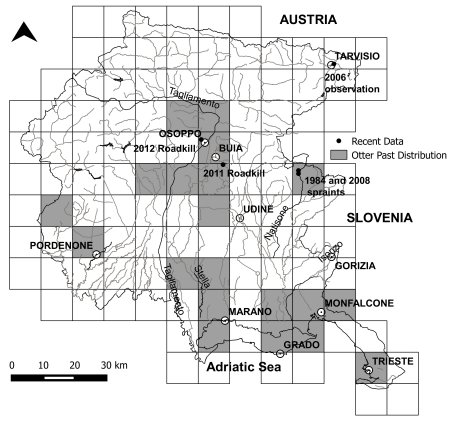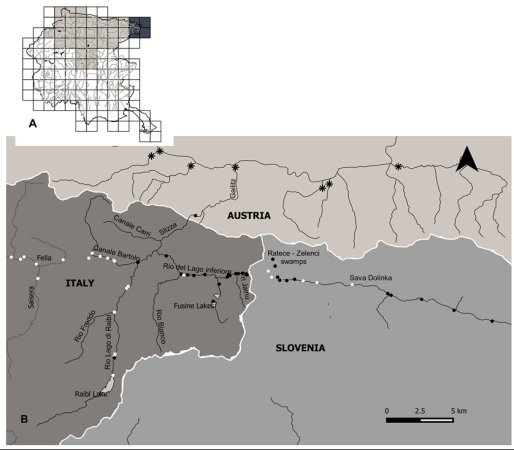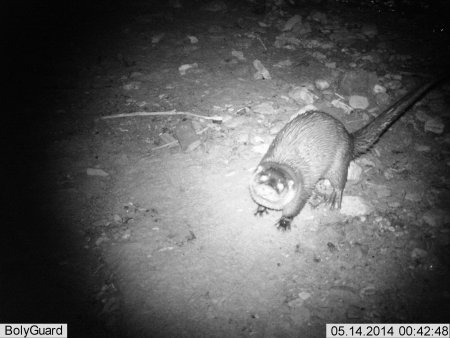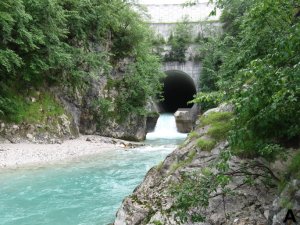IUCN/SSC Otter Specialist Group Bulletin

|
©IUCN/SCC Otter Specialist Group Volume 32 Issue 1 (January 2015) Citation: Pavanello, M, Lapini, L, Kranz, A and Iordan, F (2015). Rediscovering the Eurasian Otter (Lutra Lutra L.) in Friuli Venezia Giulia and Notes on its Possible Expansion in Northern Italy. IUCN Otter Spec. Group Bull. 32 (1): 12 - 20 Rediscovering the Eurasian Otter (Lutra Lutra L.) in Friuli Venezia Giulia and Notes on its Possible Expansion in Northern Italy Marco Pavanello1, Luca Lapini2, Andreas Kranz3 and Francesca Iordan4
1Therion Research Group, loc. Tridis 1, 33090 Tramonti di Sotto (PN) - Italy
Email:libellularaminga@gmail.com |



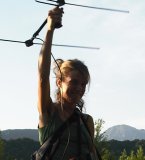
|
| Received 15th February 2015, accepted 1st April 2015 |
| Abstract: In Italy otters occur in two small populations in the South, while in the Alps they have been extinct for about 50 years. In Austria, the species is recovering and re-colonizing the Southern part of the country. The first record of the species in the Italian Alps goes back to 2008, when otters were found in the most upper catchment of the River Drau in the Region Trentino Alto Adige – South Tyrol. In the Region Friuli Venezia Giulia (NE Italy), in 2011 and 2012 two otters were found road killed within the catchment of the River Tagliamento. These findings prompted an otter survey, carried out in spring 2014 along the catchment of the upper Tagliamento and the Italian side of the River Slizza-Gailitz, which drains the area of Tarvisio and joins the River Drau in Austria, near Villach. The survey covered an area of 3200 km2. A total of 138 bridges and 16 stretches of 600 m were checked along the river banks for otter signs, i.e. spraints and tracks. Otter signs were found at 27 of the investigated sites, in the area of Tarvisio along the River Slizza-Gailitz (Drau catchment), but not in the catchment of the Tagliamento. Like for individuals found in Alto Adige – South Tyrol otters living in the area of Tarvisio belong to the River Drau population in Austria. |
| Keywords: Lutra lutra; distribution survey; Tagliamento catchment; Drau catchment |
| Française | Español |
INTRODUCTION
The Eurasian otter (Lutra lutra L.) is currently one of the most endangered mammals in Italy (Loy et al., 2010). During the first half of the 20th century, the species was still widespread throughout the country (Cassola, 1986), while it is now confined to the central and southern part of the peninsula (Loy et al., 2010).
In the Region Friuli Venezia Giulia in the north-eastern part of Italy, the otter went extinct during the 1960s (Lapini, 1986), but available information about its historical distribution in the region is fragmentary. The species had been reported in the south-eastern province of Trieste (Muggia saltworks-marshes), on the Rivers Timavo and Isonzato and in the surroundings of Grado and Monfalcone (province of Gorizia). Otters were common also in the hilly central part of the region, on the middle course of the River Tagliamento and its tributaries, in the catchment of the River Soča-Isonzo, on the border with Slovenia, in the surroundings of the Marano lagoon and throughout the southern plains. In the western part of the region (province of Pordenone), the species had been recorded on the River Noncello (Lapini, 1986; De Marinis and Lapini, 1994). No sound data are available for the Alps, while in the Julian and Carnic Pre-Alps the species had been reported only rarely (Lapini, 1986) (Figure 1).
In the neighbouring countries, otters are relatively widespread. In Slovenia the most continuous and viable population occurs in the Goričko Nature Park, in the north-eastern part of the country along the Mur Basin (Hoenigsfeld Adamič et al., 2004), but the presence of the species has been also reported on the rivers Idrica and Vipava-Vipacco (Soča-Isonzo catchment) (Hoenigsfeld-Adamič, personal communication). A few records exist also for the Italian side of this catchment in 1984 and in 2008 (Lapini and Bonesi, 2011), that represent the first signs of otter presence in Friuli Venezia Giulia after its extinction during the 1960s (Figure 1).
In Austria otters are currently expanding west- and southward and are quite common in Carinthia, along the River Gail and its tributaries, which belong to the Drau catchment (Kranz et al 2005; Kranz and Polednik 2009). The border between Italy and Austria is characterized by steep and rocky mountains, reaching high elevations up to ~ 2800 m and by the presence of two possible corridors (approximately 180 km distant from each other), which otters could use to recolonize the river network of northern Italy: one in the area of Dobbiaco (Alto Adige – South Tyrol, ~1200 m a.s.l.), moving along the River Drau and the other one in the area of Tarvisio (Friuli Venezia Giulia, ~600 m a.s.l.), moving along the River Slizza-Gailitz.
In 2008, otter signs were found in the province of Bolzano (Alto Adige - South Tyrol), where the River Drau has its origin (Kranz, 2008). Successive surveys confirmed the stable presence of the species in that area (Righetti, 2011).
The first evidences of a possible return of the otter in Friuli Venezia Giulia date back to the first decade of 2000. In 2006, an otter was sighted near Tarvisio in the internal water-basin of a steelworks along the River Rio del Lago Inferiore, a tributary of the River Slizza-Gailitz, which flows into the River Gail (Paolo Molinari, personal communication). In September 2011, a ~ 6 years old adult male was found road-killed on a secondary road in Treppo Grande municipality (province of Udine) (Lapini and Bonesi, 2011). In August 2012, another male was found dead on a road-bridge of the A23 highway, near the village of Trasaghis (province of Udine), about 10 km away from the previous individual (http://www2.units.it/lontra/). Both records were in the catchment of the River Tagliamento (Figure 1).
These recent findings prompted the realization of an otter survey in Friuli Venezia Giulia along the upper and middle part of the Tagliamento catchment and along the River Slizza-Gailitz and its tributaries, which drains the area of Tarvisio and joins the River Drau in Austria, near Villach. The aim of this survey was to investigate whether otters were re-colonizing the river network of the Region Friuli Venezia Giulia and to identify which colonization routes they could follow to re-establish in NE Italy
METHODS
The otter survey was conducted from end of March to end of May 2014 and included the upper and middle sections of the River Tagliamento (from its source to the confluence with the River Ledra) and its tributaries, the River Slizza-Gailitz and its tributaries and a 20 km long stretch of the River Sava Dolinka in Slovenia. Also the banks of the Lakes Cavazzo, Raibl and Fusine, the Vuarbis swamp and the Italian and Slovenian sides of the Rateče swamp were surveyed.
Otter presence was investigated through searching for spraints and tracks at bridges, which are often used as marking sites (Macdonald, 1984), maximizing the probability of finding signs (Macdonald and Mason, 1988; Chanin, 2003). According to Romanowski et al. (1996) bridges with boulders, natural banks, wooden or concrete ledges underneath were considered as suitable sprainting sites (“suitable bridges”), while those lacking such features were considered unsuitable (“unsuitable bridges”). The survey was conducted on a UTM, 10x10 km grid base. For each 100 km2 square, all suitable bridges were checked for otter signs, but no survey of the banks was performed. The bridge was considered as “positive” when at least a single otter sign was found and “negative when no otter sign was found.
When a square included less than four suitable bridges, an approximately 600 m long river stretch was surveyed in place of each missing bridge.
RESULTS
A total of 26, 600 m long river stretches was surveyed for otter presence (total walked length of rivers =15.60 km) and 382 bridges were identified within the investigated area. Out of them, 138 were classified as suitable (36%) and 244 as unsuitable (64%). The majority of the surveyed squares (55%) included at least four suitable bridges (N max suitable bridges per square = 13).
The presence of otters was recorded at 27 of the investigated sites (i.e. suitable bridges + 600 m long river stretches). They were situated along the River Slizza-Gailitz, between the town of Tarvisio (Italy) and the village of Maglern (Austria), and on its right-bank tributaries (Rio del Lago Inferiore, Rio Bianco, Rio del Lago di Raibl, Pri Jalnu), including the banks of the upper Fusine Lake (Figure 2). All these watercourses belong to the catchment of the River Drau. Spraints were also found on both the Italian and Slovenian sides of Rateče swamp, and along the River Sava Dolinka (Figure 2A), up to the village of Kranjska Gora, in Slovenia. Bridges positive for otters belonged to four UTM squares, all located in the north-eastern corner of the region (Figure 2A). The past occasional records suggest the colonization process of this area might have started about eight years ago. No signs of otter were found along the Tagliamento catchment.
Otter tracks of three different individuals walking in group (width: 5.5 cm, 6.0 cm and 7.0 cm) were found both on the Rio del Lago Inferiore, and throughout the Italian side of Rateče swamp, suggesting the existence of a resident family group composed by a female and two yearlings (Sidorovich, 2009). Successively, camera traps set in the area confirmed the presence of a reproductive female (S. Pecorella and R. Pontarini, personal communication) (Figure 3).
DISCUSSION
Results of our survey confirm that the Eurasian otter has colonized the Italian side of the River Slizza-Gailitz in the area of Tarvisio, close to the border between Austria and NE Italy. About the origin of the individuals living in this area, we can hypothesize that they could have arrived from Austria, through the River Slizza-Gailitz or from Eastern Slovenia through the River Sava Dolinka and the Rateče swamp, or from both directions (Figure 2).
Route through Austria
Otter presence has been reported for the River Gail since 2009 (Kranz et al., 2005; Kranz and Polednik, 2009) and results from our survey confirmed the presence of this species also in the Austrian part of the River Slizza-Gailitz. Although this river crosses the Italian-Austrian border, thereby potentially constituting a direct route for the return of otters in NE Italy from Austria, the river flows inside a ca. 400 m long artificial tunnel upstream this border, ending with a 5-6 m high artificial waterfall, surrounded by vertical cliffs (Figure 4A). The whole structure represents a potential barrier for otters, which could be avoided only by leaving the river some hundreds meters downstream the waterfall and travelling overland for at least 1 km, climbing a steep bank.
Routes through Slovenia
No systematic survey has been recently performed to update the otter distribution in Slovenia. Few data indicate its presence in the Ljubljana Marshes (ca. 80 km SE of Tarvisio), in Grosupeljska Kotlina (sources of the River Krka, ca. 110 km ESE of Tarvisio), along the Rivers Kolpa and Solta, on the border with Croatia (http://lutra.si/) and along the River Kokra, one of the tributaries of the River Sava in the area of Kranj (Pavanello personal observation, Autumn 2014). During our survey it was possible to assess the occurrence of otters in the upper part of the River Sava (e.g. along the Sava Dolinka) up to Kraniska Gora. The watershed between the River Sava and the River Slizza-Gailitz, is a smooth, low saddle (860 m a.s.l.), characterized by the presence of two swamps (Ratece and Zelenci swamps), which could functionally connect the two rivers (sensu Bélisle 2005) and therefore could facilitate otter movements between them (Figure 4B).
Further field investigations and the application of genetic monitoring on otters from northern Italy, Carinthia and Slovenia could clarify the origin of the individuals living along the Italian side of the Slizza-Gailitz catchment and the route they followed to colonize it.
COLONIZATION OF THE NORTHERN ADRIATIC BASIN
The presence of a reproductive group in the area of Tarvisio is in support of a natural recolonization by otters of suitable watercourses of NE Italy. This could happen through the catchment of the River Tagliamento, which belongs to the Northern Adriatic Basin. In Friuli Venezia Giulia the watershed between the River Slizza-Gailitz and the Tagliamento catchment is the Camporosso saddle. On the western slope of this smooth and low pass (816 m a.s.l.) the River Fella, a major tributary of the River Tagliamento, flows. On the eastern slope, two kilometres apart from it, the River Canale Bartolo flows into the River Slizza-Gailitz, theoretically representing an easy connection between the Danube basin and the Northern Adriatic basin (Figure 2). Another possible corridor for the re-colonization of the Northern Adriatic Basin is along the Soča-Isonzo catchment, where otters were present in the past (Kryštufek, 1991) and evidences of the presence of vagrants date back to the 1980s and the 2000s (Lapini and Bonesi, 2011; Figure 5). The re-colonization along this catchment could occur either directly along the main course of the River Soča -Isonzo, which crosses the border between Italy and Slovenia in the area of Gorizia, or through some tributaries like the River Nadiža-Natisone and the streams, Ucja-Uccea and Vipava-Vipacco (Figure 5). The only other option for the species to re-colonize the Northern Adriatic basin is in Trentino Alto Adige – South Tyrol, moving southward from the River Drau to the River Adige.
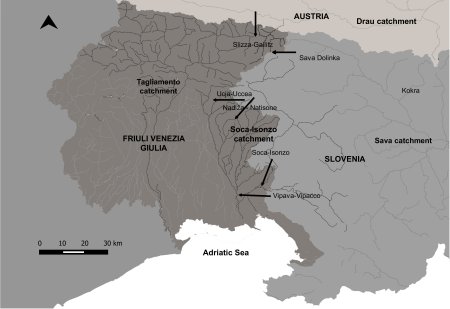
|
| Figure 5. Possible routes otter could follow to re-colonize the Region Friuli Venezia Giulia (black arrows). (click for larger version) |
IMPLICATIONS FOR FURTHER RESEARCH
The recent otter expansion in NE Italy has raised the catchments of the Rivers Slizza-Gailitz and Tagliamento to the grade of priority areas for the conservation and expansion of this species in Italy. Given the importance that the new discovered otter nuclei could have for the re-colonization of the Northern Adriatic basin, periodical sign surveys should be carried out both in South Tyrol and Friuli Venezia Giulia, particularly along the catchments of the Rivers Adige, Tagliamento and Soča-Isonzo to update otter distribution and monitor the ongoing recolonization process.
Moreover, species distribution and connectivity models should be produced for identifying the existence of functional paths (i.e. suitable connected habitats within catchments, see Cianfrani et al., 2013), which could facilitate the expansion of otters in Friuli Venezia Giulia. Several studies carried out in Europe revealed that for the inter-catchment dispersal of otters, the permeability of the matrix is in the same order of magnitude in importance as the topological position of the available habitats along the river network (e.g. Loy et al., 2009; Carranza et al., 2012; Cianfrani et al., 2013).
With the identification of functional paths, the areas where anthropogenic factors are responsible for low habitat quality might be improved through conservation or restoration programs in order to enhance the expansion and the natural re-colonization of the whole Northern Adriatic basin by otters, as also indicated by the Italian Action Plan for the species (Panzacchi et al., 2011).
Acknowledgements - We would like to thank all the people who made possible to realize this study: first of all Alfredo Altobelli (Life Science Department - Trieste University) and Michele Ferretto (Cooperativa Biosphaera, San Vito di Leguzzano), for giving all the support which was needed to perform it and bring it to a conclusion. Special thanks to Cristina Rieppi, Marko Zupan, Luca Dorigo, Stefano Pesaro and Andrea Caboni of the Therion Research Group and to Federica Fonda for helping during the fieldwork, to Stefano Pecorella and Renato Pontarini for providing data and images obtained through camera-traps and to Paolo Molinari for providing useful information about otter presence in the study area before the survey was conducted. Last but not least: Lukaš Polednik and Katerina Poledniková from Alka Wildlife for the precious advices on fieldwork methodologies, Laura Bonesi for language revision, Alessandro Balestrieri from the University of Pavia for text revision and Yolanda Melero and Matthieu Gibert for abstract translations. Francesca Iordan was sponsored by the Region Friuli Venezia Giulia (Bando SHARM 2013)..
REFERENCES
Bélisle, M. (2005). Measuring landscape connectivity: the challenge of
behavioral landscape ecology. Ecology 86:1988–1995.
Bonesi, L. (2006-2012). La lontra: segnalazioni lontre in Italia.
Available from http://www2.units.it/lontra/
[14 February 2015].
Carranza, M.L., D’Alessandro, E., Saura, S., Loy, A. (2012). Assessing habitat connectivity for semi-aquatic vertebrates. The case of the endangered otter in Italy . Landscape Ecology 27 (2): 281-290
Cassola, F. (1986). La lontra in Italia. Censimento, distribuzione e problemi di
conservazione di una specie minacciata,World Wildlife Fund, Rome.
Chanin, P. (2003). Monitoring the Otter Lutra lutra. Conserving Natura 2000 Rivers Monitoring Series No. 10, English Nature, Peterborough
Cianfrani, C., Maiorano, L., Loy, A., Kranz, A., Lehmann, A., Maggini, R., Guisan, A. (2013). There and back again? Combining habitat suitability modelling and connectivity analyses to assess a potential return of the otter to Switzerland. Animal Conservation, 16: 584-594.
De Marinis, A., Lapini, L. (1994). Collections of Italian Mustelidae (Mammalia, Carnivora) housed in Italian Museums. Boll.Mus. Reg. Sci. Nat. Torino 12, 255-325.
Hoenigsfeld Adamič, M., Sain Slak, A., Kosi, G., Perovsek, D. (2004). The Hodos Lake - Eurasian otter (Lutra lutra) habitat node. Geografski Obzornik 51: 12-17
Kranz, A. (2008). Südtirol: Fischotter im Oktober 2008 nachgewiesen. In Wild und Jagd in Europa. Anblick 11/2008.
Kranz, A. Polednik L. (2009). Verbreitung und Erhaltungszustand 2009 in Kärnten. Endbericht im Auftrag der Abteilung 20 des Amtes der Kärntner Landesregierung.
Kranz, A., L. Polednik, Toman, A. (2005). Aktuelle Verbreitung des Fischotters (Lutra lutra) in Kärnten und Osttirol. Carinthia II 195: 317-344.
Kryštufek, B. (1991). Sesalci Slovenije, Prirodoslovni muzej Slovenije, Ljubljana.
Lapini L. (1986). La lontra in Friuli Venezia Giulia. In: La lontra in Italia - Censimento, distribuzione e problemi di conservazione di una specie minacciata, World Wildlife Fund, Rome.
Lapini, L., Bonesi, L. (2011). Evidence of a natural recovery of the Eurasian otter in NE Italy. 29th European Mustelid Colloquim, Southampton (UK).
Loy, A., Carranza, M.L., Cianfrani, C., D'Alessandro, E., Bonesi, L., Di Marzio, P., Minotti, M., Reggiani, G. (2009). Otter Lutra lutra population expansion: Assessing habitat suitability and connectivity in southern Italy. Folia Zoologica, 58: 309-326.
Loy, A., Boitani, L., Bonesi, L., Canu, A., Di Croce, A., Fiorentino, P.L., Genovesi, P., Mattei, L., Panzacchi, M., Prigioni, C., Randi, E., Reggiani, G. (2010). The Italian action plan for the endangered Eurasian otter Lutra lutra. Hystrix 21: 19-33.
Lutra (2009-2014). Sanje o kraljestvu povodnega moža. Available from: http://lutra.si/ [15 February 2015].
Macdonald, S. M. (1984). British National Survey Method. IUCN Otter Specialist Group Bulletin 1: 11-12.
Macdonald S. M., Mason, C.F. (1988). Observations of an otter population in decline. Acta Theriologica 33: 415-434.
Panzacchi, M., Genovesi, P., Loy, A. (2011). Piano d’Azione Nazionale per la Conservazione della Lontra (Lutra lutra). Quad. Cons. Natura, 35, Min. Ambiente - ISPRA.
Righetti, D. (2011). Return of the otter in South Tyrol (NE Italy).Proc. XI Otter Colloquium. Hystrix (supp.).
Romanowski, J., Brzezicki, M., and Cygan, J. P. (1996). Notes on the technique of the otter field survey. Acta Theriologica 41: 199-204.
Sidorovich, V. (2009). Guide to mammal and bird activity signs. Zimaletto, Minsk.
Résumé : Reapparition de la Loutre (Lutra lutra) en Friuli Venezia Giulia et Commentaires sur sa Possible Expansion en Italie du Nord
En Italie, on trouve deux petites populations de loutre dans le sud du pays, alors que l'espèce s'est temporairement éteinte il y a 50 ans dans les Alpes. En Autriche, l'espèce est entrain de recoloniser la partie Sud du pays. La première observation de loutre dans les Alpes Italiennes remonte à 2008, avec la présence de quelques spécimens dans la partie haute du bassin de la rivière Drave, dans le Trentino Alto Adige. Dans le Friuli Venezia Giulia deux loutres ont été retrouvées mortes sur la route dans le bassin de la rivère Tagliamento. Ces découvertes ont entrainé au printemps 2014 la réalisation d'une étude sur la loutre, le long de la partie haute du bassin du Tagliamento et sur la rive Italienne de la Slizza-Gailitz, qui s'écoule dans la zone de Tarvisio et se jette dans la Drave en Autriche, près de Villach. L'étude couvre une zone de 3200 km2. Un total de 382 ponts et 16 sections de 600m ont étés vérifiés le long de la berge à la recherche d'excréments et d'empreintes signalant la présence de loutres. Ces indices ont été trouvés sous 15 ponts dans la zone de Tarvisio le long de la Slizza-Gailitz mais aucun n'apparait dans le bassin du Tagliamento. .
Revenez au dessus
Resumen: Redescubriendo la Nutria Eurasica (Lutra Lutra) en Friuli Venezia Giulia y Notas sobre su Posible Expansion por el Sur de Italia.
En el sur de Italia, la nutria se distribuye en dos pequeñas poblaciones mientras que en los Alpes la especie se extinguió hace 50 años. En la vecina Austria, la especie se está recuperando y recolonizando el sur. El primer registro de nutria en los Alpes italianos data de una observación en vivo en el 2008, en la zona más alta de la cuenca del río Drau en la región de Trentino Alto Adige. En 2011 y 2012 se encontraron dos nutrias muertas en la cuenca del río Tagliamento, región Friuli Venezia Giulia. Estos encuentros dieron lugar a la realización de un sondeo de la especie durante la primavera de 2014 a lo largo de la cuenca alta del río Tagliamento y el lado italiano del río Slizza-Gailitz el cual riega el área de Tarvisio y se une al río Drau en Austria cerca de Villach. El sondeo cubrió un área de 3200km2. Se rastreó un total de 382 puentes y 16 tramos de 600m a lo largo de las orillas de los ríos en busca de señales de nutria, como por ejemplo excrementos y huellas. Se encontraron señales en 15 puentes del área de Tarvisio a lo largo del río Slizza-Gailitz, pero no en la cuenca del río Tagliamento.
Vuelva a la tapa
